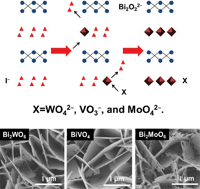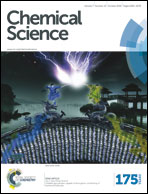Fabrication of porous nanoflake BiMOx (M = W, V, and Mo) photoanodes via hydrothermal anion exchange†
Abstract
Most Bi-based photoelectrodes have suitable band gaps and can effectively promote the water oxidation reaction. However, simple preparation methods for Bi-based binary metal oxides as photoanodes are scarce. This paper describes a simple hydrothermal anion exchange method to synthesize Bi-based binary metal oxides with controlled morphologies. This synthesis process uses BiOI as the template and Bi source, which is eventually converted to Bi-based porous nanoflake photoanodes upon reaction with MOx (M = W, V, and Mo)-containing precursors. The photoanodes show well-shaped porous nanoflake morphologies and exhibit impressive photoelectrochemical properties compared to Bi-based photoanodes synthesized by conventional methods. These three samples possess long-term stability under solar irradiation and show considerable photocurrent for sulfite oxidation.

- This article is part of the themed collection: Global Energy Challenges: Materials and Nanotechnology

 Please wait while we load your content...
Please wait while we load your content...